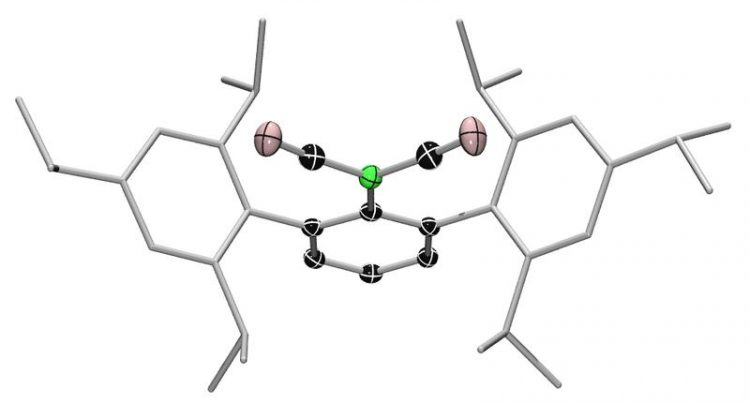First complexation of multiple CO molecules to a non-metal atom

Caption 1: Molecular structure of the borylene-dicarbonyl in the solid determined by x-ray structure analysis (Picture: Dr. Florian Hupp and Dr. Krzysztof Radacki)
Scientists of Professor Holger Braunschweig's team of the Institute of Inorganic Chemistry at the University of Würzburg have successfully bound two carbon monoxide molecules (CO) to the main group element boron in a direct synthesis for the first time. The result is a borylene-dicarbonyl complex.
Such complexes, or coordination complexes, are generally made up of one or more central molecules and one or more ligands. The central molecules are usually atoms of transition metals.
“Binding one CO molecule to a main group element is already extraordinary. Bonding two molecules two one non-metal atom is even more extraordinary,” says chemist Rian Dewhurst. Dewhurst, who is working on Professor Holger Braunschweig's team, submitted the article together with several co-authors. It is the first work of the institute to have been accepted by the journal Nature.
“In future, borylene-dicarbonyls could be used to mimic the properties of transition metal carbonyl complexes,” Dewhurst further. Transition metals have specific electronic properties. These elements from group four to twelve in the periodic table have the ability to bind multiple carbon monoxide molecules relatively easily.
Advantages of boron compounds
Generally, boron compounds are important for various industrial applications. They are used, for example, in catalytic processes, in various molecular and solid materials or in the production of pharmaceutical drugs. A catalyst accelerates a desired chemical reaction without being consumed in the process.
Boron has the advantage of being readily available and comparably low-priced. It occurs naturally mostly in mineral form and is mined in borate mines in California and Turkey, for example. Moreover, the element is non-toxic for humans and other mammals. “Combined with its unique electronic properties, this makes boron very interesting for industrial and other commercial uses,” Dewhurst explains.
Boron is a highly reactive element. With three electrons on the outer shells, boron strives to form bonds that enable eight electrons, which the noble gases neon, argon or xenon already have in their basic state.
Lone electron pair at the central molecule
The borylene-dicarbonyl complex also has eight electrons involved in the bonds to the boron atom. With two electrons, respectively, presenting the bonds to the two CO molecules and two others binding one hydrocarbyl, the researchers were able to establish one lone electron pair amounting to eight electrons in total. “It is the lone electron pair that makes the complex special. The hydrocarbyl assures stability. It shields the structure in a manner of speaking,” says Marco Nutz, a doctoral candidate. He adds: “Most compounds that can be isolated in this way are unstable outside a protective atmosphere.” The Würzburg discovery, however, remains stable for several days even in a “normal” environment exposed to air and moisture.
Dewhurst and Nutz are conducting basic research. “In a next step, we are going to further investigate the compound we have presented. We are pursuing different angles here,” Dewhurst says. One focus will be to compare the properties of conventional transition metal carbonyl complexes with those of the borylene-carbonyl complex in detail.
In recent years, the attention of natural science has progressively focused on boron. According to Dewhurst, the increasing significance of boron is also reflected in the growing interest in the element on the part of organic chemistry and in the fact that material science, too, is closely following the advances made in boron complex research.
“Multiple Complexation of CO and Related Ligands to a Main Group Element” by Holger Braunschweig, Rian D. Dewhurst, Florian Hupp, Marco Nutz, Krzysztof Radacki, Christopher W. Tate, Alfredo Vargas, Qing Ye. Nature vol 522, issue 7556 pp.327-330, DOI 10.1038/nature14489
Contact:
Prof. Holger Braunschweig, Institute of Inorganic Chemistry at the University of Würzburg
Phone: +49 931 31-88104, e-mail: h.braunschweig@uni-wuerzburg.de
http://www.presse.uni-wuerzburg.de University's press office
Media Contact
All latest news from the category: Life Sciences and Chemistry
Articles and reports from the Life Sciences and chemistry area deal with applied and basic research into modern biology, chemistry and human medicine.
Valuable information can be found on a range of life sciences fields including bacteriology, biochemistry, bionics, bioinformatics, biophysics, biotechnology, genetics, geobotany, human biology, marine biology, microbiology, molecular biology, cellular biology, zoology, bioinorganic chemistry, microchemistry and environmental chemistry.
Newest articles

A universal framework for spatial biology
SpatialData is a freely accessible tool to unify and integrate data from different omics technologies accounting for spatial information, which can provide holistic insights into health and disease. Biological processes…

How complex biological processes arise
A $20 million grant from the U.S. National Science Foundation (NSF) will support the establishment and operation of the National Synthesis Center for Emergence in the Molecular and Cellular Sciences (NCEMS) at…

Airborne single-photon lidar system achieves high-resolution 3D imaging
Compact, low-power system opens doors for photon-efficient drone and satellite-based environmental monitoring and mapping. Researchers have developed a compact and lightweight single-photon airborne lidar system that can acquire high-resolution 3D…





















